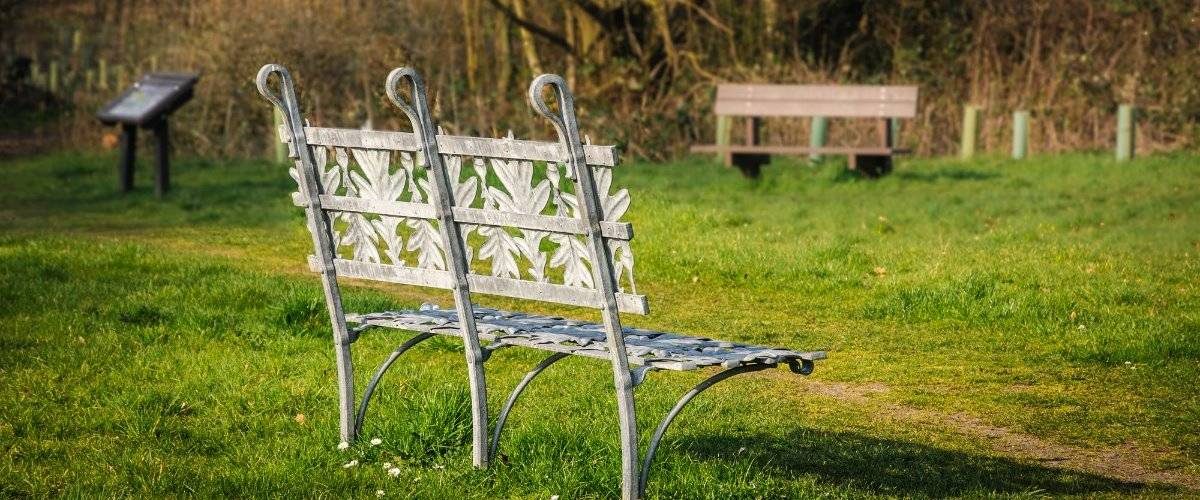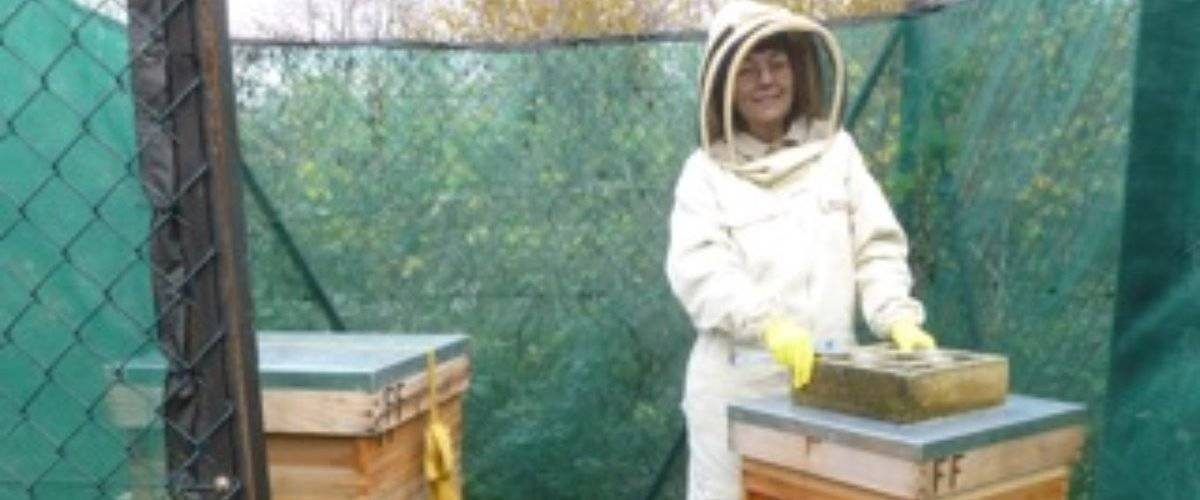
Welcome to Fishers Field Local Nature Reserve & Fishers Park.
I want to...


Open all year
Including the new Fishers Park Open Space, North Bushey
Feature Tree
Tree 1 Prunus avium – Wild Cherry
This is a beautiful native woodland tree and can grow up to 30 metres. It has shiny red-brown bark which peels. Delicate white blossom appears in April-May just before leaves. Bitter fruits (cherries) turn from yellow to dark- red as they ripen and are popular with birds, mice and squirrels. You will often find cherry stones around the base of the tree in late summer. The leaves turn fiery colours of yellow and crimson in autumn. The wood is used in musical instruments and crafts.
Feature Tree
Tree 4 Crataegus monogyna – Hawthorn
Origin: Native
Be careful – this tree has very sharp thorns! This tree can reach 10 metres and forms an attractive umbrella shape in spring. Dark red berries provide food for many of our native and winter visiting birds. It has beautiful fragrant, white flowers known as May blossom, which appear in spring. It is also known as the ‘May Tree’ due it its ancient associations with May Day festivities (used as May Pole and May Day garlands) and much superstition surrounds it – it is unlucky to bring flowers inside the home. It is also referred to as ‘Christ’s Crown of Thorns’ due to the sharp thorns.
Woodland
In early 2012, the Friends successfully secured a Hertsmere Small Project grant, which along with additional funding from the Watling Chase Community Forest match funded with volunteer hours, was used to create this hazel coppice.
This small area (0.1ha) of hazel woodland was planted with 600 whips and is coppiced in sections using traditional methods by volunteers.
Feature Tree
Tree 2 Aesculus hippocastanum Horse Chestnut
A magnificent spreading tree which can grow up to 35 metres and casts a welcoming shade in summer. The tree has big leaves, almost like fingers, and showy candle flowers in May. It has sticky dark red buds in winter. Look out for horseshoe marks and ‘nail holes’ on the branches around where the buds will appear. The fruit is enclosed in leathery cases providing a popular autumn game – ‘conkers’. This is a popular tree in parks, avenues and is often seen on village greens. The wood is not very strong and is used in small items such as toys.
Wildlife
Two magnifying posts, robinia wood posts topped with magnifying glasses, are installed either end of the welly boot path for children and adults alike to study the wild flora and fauna.
Seating
Stephen Rook, former Chair of the Friends of Fishers Field and a master blacksmith, forged a bespoke galvanised steel bench.
Stephen designed the bench, a work of art showing oak leaves and acorns, to commemorate the late Joe Wiggs, his father-in–law and a
founder member of the Friends. The bench was installed in May 2013.
Feature Tree
Tree 5 Quercus robur – English Oak
The Oak supports the most variety of wildlife. Often referred to as ‘The Tree of Life’. The Oak is one of the oldest trees in England and can live to over 700 years and reaches an eventual height of 30 metres.
The acorns provide an abundant food source for squirrels who you will see rushing around in autumn burying their store ready for winter. Often these acorns are forgotten and young oak trees (‘saplings’) start to appear.
Being of such ancient origin, there are many myths that surround the tree: Merlin’s wand was made from oak, King Arthur’s Round Table was made from one enormous slice of oak tree; Charles II hid in an oak tree following his defeat at the Battle of Worcester and this became the Royal Oak; couples used to be married under oak trees before the establishment of churches.
The Oak can be recognised by its spreading form and its distinctive leaves.
Fitness Equipment
The green gym equipment similarly provides an interesting and safe space for adults, and encourages people to exercise and experiment with new ways of doing so for free.
Three piece of fitness equipment were installed providing a short circuit:-
Leg Raise station
Set of Hurdles
Set of Monkey Bars.
Playground
The play area in Fishers Park is a valuable resource for families and provides an interesting and safe space for children to play be active.
Four Way Springer
Free Standing Slide
Speed Gyro Roundabout
Steel Balance Beam
Basket Swing
Trampoline
Water Habitat
With the help of the Hertfordshire Fire Brigade and funding from a local Councillor, the Friends installed the wildlife pond in 2010. Each year, volunteers assist with thinning out vegetation to conserve the water habitat.
Marginal and aquatic plants include flag iris, purple loosestrife and frogbit.
Feature Tree
Tree 3 Populus – Poplar
A very easy tree to identify due to its tall narrow shape – the branches point stiffly upwards. It can reach a height of 30 metres. Furry catkins appear in March-April before the triangular leaves. The Poplar is planted in parks or in rows to form a screen. Poplars can ‘weep’ a sticky residue which is thought to be linked to a Greek legend. They represent the tears of the seven Heliades, sisters of Phaeton who was punished by Zeus.
Feature Tree
Tree 6 Sorbus aucuparia – Rowan
This is a fast growing tree, recognisable by its white flowers, red berries and feathery 5-8 pairs of toothed leaflet. It is a common tree across Europe, Asia and North Africa at home in woodlands, urban areas and nature reserves and is a favourite for wildlife especially birds.
Historically, Rowan was once widely planted by houses as a protection against witches – luckily something we don’t need to worry about here! The wood was also used for stirring milk to prevent the milk curdling and as a pocket charm against rheumatism. It was also used to make divining rods.
Feature Tree
Tree 7 Betula pendula – Silver Birch
A slender elegant tree, reaching 30 metres, with ghostly white bark and as it ages develops ‘warts’. Timber is used in making plywood and is popular amongst turners. Its wispy branches were used in making besom (witches) broom heads. Attractive yellow drooping catkins appear in Spring and oval bright green leaves follow, turning yellow in autumn.
It is one of only two dedicated Nature Reserves on the borough of Hertsmere and is registered as a Local Nature Reserve with Natural England.
Formally a dis-used allotment site, in 1994 the local community lobbied for this valuable area of green belt to be turned over to a public open space and Fishers Field was created.
From inception, the Friends of Fishers Field, all local residents, have worked in partnership with Hertsmere Borough Council and Countryside Management Service to manage, maintain, develop and promote the Reserve.
In 2017, a new public open space opened adjacent with a childrens play area, fitness equipment, seating area, King George V culvert and wildflower meadows.
Limited parking is available on Fishers Close off Bendysh Road. Directions here
There are parking bays for Fishers Park users available in the evening and weekends in Flora Road. Directions here
Public Transport Information:Further information on public transport is available here: www.intalink.org.uk and www.nationalrail.co.uk
Cycling:No cycling is permitted on the nature reserve

Welcome to Fishers Field Local Nature Reserve & Fishers Park.
I want to...
Share your experience
Tell your friends on social media about what you did at Fishers Field Local Nature Reserve & Fishers Park: